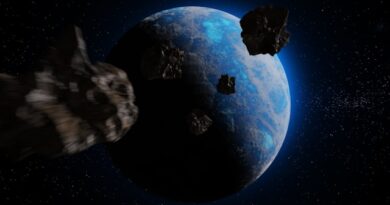Distorted Sound from the Primordial Universe Suggests We Live in a Giant ‘Void’
The existence of a “void” in the local Universe could help resolve contradictions in measurements of the Universe’s expansion rate.
When gazing at the night sky, it may seem like our cosmic neighborhood is teeming with planets, stars, and galaxies. But scientists have long suggested that there may be far fewer galaxies in our cosmic surroundings than expected.
In fact, it appears that we live in a gigantic cosmic void, with a matter density about 20% lower than average.
Not all physicists are convinced that this is the case. But our recent paper analyzing distorted sounds from the primordial Universe, published in the journal Monthly Notices of the Royal Astronomical Society, strongly supports this idea.
Cosmology is currently facing a crisis known as the “Hubble tension”: the local Universe appears to be expanding about 10% faster than expected. The predicted rate comes from extrapolating observations of the early Universe to the present day, using the standard model of cosmology known as Lambda-Cold Dark Matter (ΛCDM).
We can observe the early Universe in great detail through the cosmic microwave background (CMB), the remnant “echo” of the Universe’s beginning, when it was 1,100 times smaller than it is today. The sound waves in the primordial Universe ended up creating areas of higher and lower density—or “temperatures.”
By studying temperature fluctuations in the CMB across different scales, we can essentially “hear” the sound of the early Universe, which is especially “loud” at specific scales.
Related topic: What phase is the Moon in during a Lunar Eclipse?
These fluctuations are now imprinted on the CMB and are called baryon acoustic oscillations (BAOs). Since they became the seeds for galaxies and other structures, the same patterns are also visible in the distribution of galaxies.
By measuring these patterns, we can learn how galaxies are clustered across different redshifts (distances). One particularly striking pattern, with many groupings, appears at an angle known as the BAO angular scale.
This measurement helps astronomers and cosmologists understand the expansion history of the Universe, providing what physicists call a “standard ruler.” This is essentially an astronomical object or feature in the sky with a well-known size.
By measuring its angular size in the sky, cosmologists can calculate its distance from Earth using trigonometry. They can also use redshift to determine the expansion rate of the Cosmos. The larger it appears in the sky at a given redshift, the faster the Universe is expanding.
My colleagues and I previously argued that the Hubble tension could be due to our location within a large void. This is because the low amount of matter in this void would be gravitationally pulled toward the denser matter outside of it, continuously flowing outward.
In earlier research, we showed that this flow would make it seem like the local Universe is expanding about 10% faster than expected. That would resolve the Hubble tension.
But we wanted more evidence. And we know that a local void would slightly distort the relationship between the BAO angular scale and redshift due to matter moving faster inside the void and its gravitational effect on incoming light.
So, in our new paper, Vasileios Kalaitzidis and I set out to test the predictions of the void model using BAO measurements collected over the past 20 years. We compared our results with non-void models under the same background expansion history.
In the void model, the BAO ruler should appear larger in the sky at any given redshift. And this excess should become even greater at low redshift (near distance), in line with the Hubble tension.
Observations confirm this prediction. Our results suggest that a Universe with a local void is about one hundred million times more likely than a Universe without one when using BAO measurements and assuming expansion according to the ΛCDM model informed by the CMB.
Our research shows that the ΛCDM model without a local void is in 3.8 sigma tension with BAO observations. This means the probability of a Universe without a void fitting this data is equivalent to a fair coin landing heads 13 times in a row. In contrast, the likelihood of the BAO data appearing as it does in void models is similar to flipping a fair coin and getting heads just twice in a row. In short, these models fit the data very well.
In the future, it will be crucial to obtain more precise BAO measurements at low redshift, where the BAO standard ruler appears larger in the sky—especially if we do live in a void.
The average expansion rate so far follows directly from the age of the Universe, which we can estimate from the ages of the oldest stars in the Milky Way. A local void wouldn’t affect the age of the Universe, but some proposals do. These and other probes will shed more light on the Hubble crisis in cosmology.
Text adapted from G1 Globo



